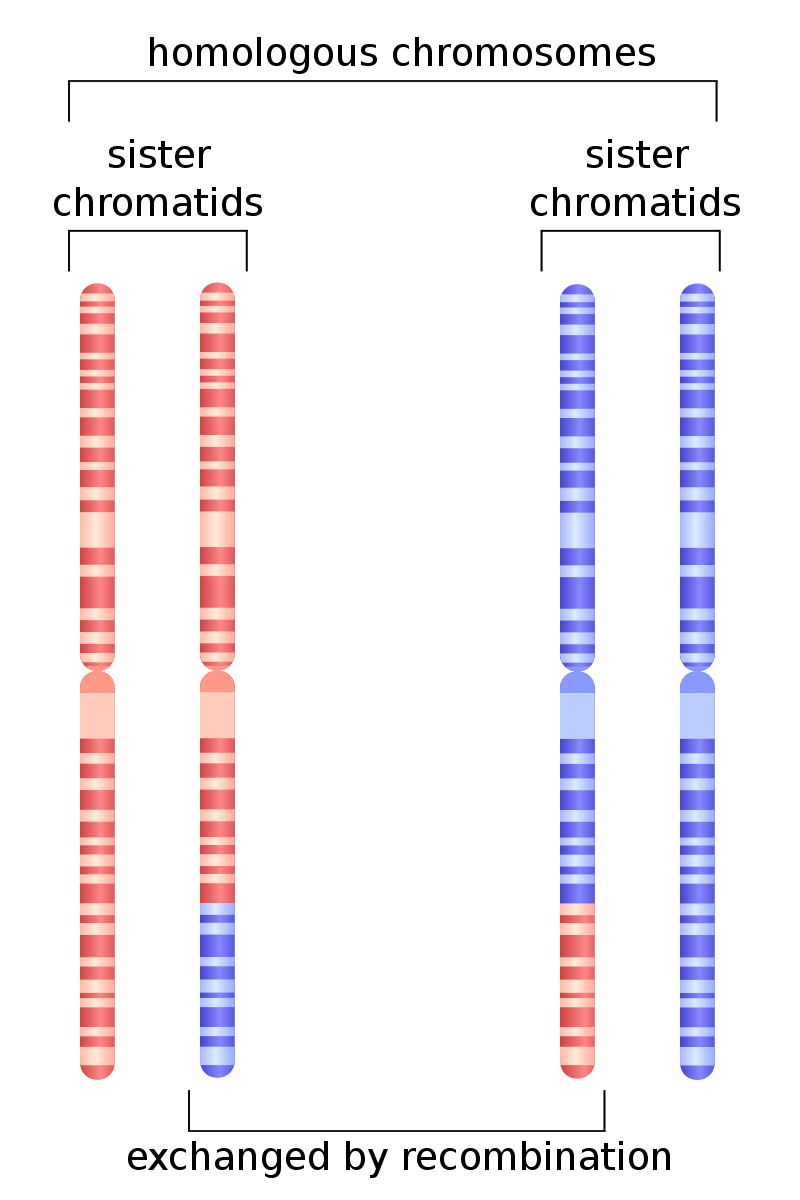Biology Forum › Genetics › Difference between homologous chromosomes and sister chromatids
- AuthorPosts
- August 9, 2021 at 8:13 am #118457
 Nadine OmarParticipant
Nadine OmarParticipantWhat are Homologous Chromosomes?
How to define homologous chromosomes? Homologous chromosomes by definition in biology are chromosomes that pair during meiosis I, particularly, in metaphase where one of the chromosomes carrying maternal information pairs with the other chromosome carrying paternal information.
The pattern in each pair of homologous chromosomes is the same since each copy contains the same number of genes arranged in the same order. However, the same or different alleles may be present on each chromosome. Therefore, the organism may be heterozygous or homozygous for a certain trait.
A single homologous chromosome is referred to as a homologue. In each pair, the position and length of centromeres are the same. In humans, 22 homologous autosome pairs are present together with 2 sex chromosomes.
Sex chromosomes are homologous in the case of females since X and X chromosomes are present, unlike males in which different chromosomes X and Y are present. Random segregation occurs during homologous chromosome pairing where both chromosomes participate in the recombination process by exchanging their DNA to produce random combinations of genetic material from homologous chromosomes. Therefore, genetic variation is significant in organisms that reproduce sexually to facilitate the evolutionary process. After their separation, homologous chromosomes produce four daughter haploid cells at the end of meiosis.
What are Sister Chromatids?
What is a chromatid? It is a single copy of a replicated chromosome that is identical to another chromatid.
How to define sister chromatids?
In biology, sister chromatids are the chromatids formed by the replicated chromosome where it forms two identical sister chromatids. Sister chromatids result in the replication of DNA during the interphase. They are separated during anaphase of mitosis and meiosis II. Sister chromatids are joined at the centromere. Are sister chromatids homologous? Sister chromatids are genetically identical so they are not considered to be homologous.
Difference Between Homologous Chromosomes and Sister Chromatids
DNA is the genetic material of most organisms. Homologous chromosomes are two copies of similar chromosomes. They appear in pairs during metaphase I of meiotic cell division. What are chromatids? sister chromatids are two identical copies formed during the interphase of DNA replication. The main difference between sister chromatids and homologous chromosomes is that sister chromatids contain the same information while homologous chromosomes may contain different information.
Homologous chromosomes and sister chromatids are composed of DNA strands, But what is the main function of homologous chromosomes and sister chromatids that differentiate them from one another? Homologous chromosomes are used during reproduction to make a new organism, they are responsible for genetic variation among sexually reproduced organisms during crossing over and exchanging random genetic material. While sister chromatids are significant during the mitotic division of cells like making new skin cells to heal wounds.
Homologous chromosomes vs sister chromatids – in your opinion, what are other major differences?
Content
Homologous chromosomes are composed of paternal and maternal chromosomes (non-sister chromatids). Homologous chromosomes have the same position of the centromere, loci, genetic sequence, and length of chromosomes. But homologous chromosomes may have different alleles. They are formed during fertilization to allow genetic recombination between their non-sister chromatids.
Sister chromatids are two identical copies of one chromosome so they come from one source only, either paternal or maternal source.

Figure 1: difference in composition of homologous chromosomes and sister chromatids.
Learn more about homologous chromosomes here: https://www.biologyonline.com/dictionary/homologous-chromosome
Genetic Composition
Do homologous chromosomes have the same genes? The genetic sequence of homologous chromosomes might differ sometimes because homologous chromosomes sometimes contain different alleles. Therefore, the chromatids of homologous chromosomes are known as non-sister chromatids.
Sister chromatids always contain identical sequences of genes within chromatids forming them.
Appearance
Homologous chromosomes are formed during the metaphase of meiosis I while sister chromatids appear during the S phase of interphase in the replication of DNA.
Similarity
Are homologous chromosomes identical? homologous pairs are slightly different in their genetic information since one homologous chromosome is maternal and the other is paternal. Therefore, they are not identical to increase the variation of the genetic material of each gamete.
Sister chromatids are identical; they are formed of the same allele in both strands since they are formed by the replication of a DNA strand.
Joining
Homologous chromosomes are found in pairs so they are not attached together.
Sister chromatids stick together.
Do you know the name of their point of attachment?
1-centrosome
2-centriole
3-cytocenter
4-centromere
Number of DNA Strands
Homologous chromosomes are found in two pairs; so they are made up of four strands of DNA.
Each sister chromatid is composed of only one strand of DNA.
Separation
Homologous chromosomes and sister chromatids usually segregate during anaphases.
When do homologous chromosomes separate?
Homologous chromosomes are separated in meiosis anaphase I.
How are sister chromatids physically separated during the cell cycle? Sister chromatids separate during anaphase by enzymatic breakdown of their cohesion at the centromere. After separation, each chromatid acts as an independent chromosome. Sister chromatids are segregated from the centromere during mitosis anaphase as well as meiosis II anaphase.
Function
During metaphase I, homologous chromosomes allow genetic recombination and random segregation of segregated chromosomes.
During meiosis metaphase II and mitosis metaphase, sister chromatids allow crossover of chromosomes and segregation of chromatids randomly.
Comment below if you want to know more about homologous chromosomes application or your questions about homologous chromosomes and sister chromatids! Let’s discuss!
- AuthorPosts
You must be logged in to reply to this topic.
